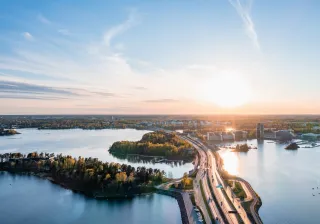What do autonomous systems, smart energy and synthetic biology have in common? They are examples of future solutions around which innovation ecosystems have formed. At VTT, we are involved in the development of these ecosystems and many others as well. We collected experiences and lessons learned about the subject around five questions.
We have found it important that the participants know what kind of an ecosystem or network structure they are dealing with at any given time.
When do we need an innovation ecosystem?
When solving systemic challenges, we need innovation ecosystems to bring together different actors and competences. Such phenomena as climate change, depletion of natural resources and the ageing of the population are multidimensional challenges, which cannot be solved through innovation processes of a single actor or a few actors together. We need not only companies that develop solutions, but also representatives of customers, end users and legislators as well as research for creating new knowledge.
How does an innovation ecosystem differ from other ecosystems and networks?
We have found it important that the participants know what kind of an ecosystem or network structure they are dealing with at any given time.
If we consider the path from research to a commercial solution as a linear process, the innovation ecosystem is located between the knowledge ecosystem and the business ecosystem. In practice, there is also overlapping between the different types of ecosystems. The knowledge ecosystem nourishes various innovation ecosystems with new knowledge, and, similarly, an innovation ecosystem may promote the development of several business ecosystems, creating piloted solutions tested in collaboration with customers.
What are the three most important factors needed for the ecosystem to generate concrete results?
In innovation ecosystems, particularly the role of an orchestrator becomes emphasised: well orchestrated work leads to quicker launch of development. The orchestrator often steers actors who all have joined the ecosystem with different initial agendas and who are used to different modes of collaborating with others, to come together and find the practices, rules and common goals suited for the ecosystem. Even though an ecosystem is not built in the same way as a company or a close, restricted network, self-organising alone is not enough in an innovation ecosystem. A good orchestrator has the ability, competence and vision to complete the mission. In addition, the parties holding the orchestrator’s role need resources to do the orchestration.
Shared understanding of the goals and a roadmap to reaching them is an essential way of steering the development of an ecosystem together with all the actors involved. The roadmap can be used to make visible the different roles and tasks the various parties of the ecosystem have in building the overall ecosystem. It may also help generate internal social pressure in the ecosystem and ensure that tasks are carried out in the jointly agreed schedule.
The most important purpose of ecosystem rules is to bring forth practices that support openness of the innovation ecosystem and to ensure that the participants are committed to the rules. There are at least two different types of openness. The innovation ecosystem may be open to everyone sharing its goals, or it may be more closed, with various levels of innovation ecosystem membership − maybe even practices by which new participants are invited into the ecosystem. The other, even more important type of openness is the openness of sharing information. When setting rules, the ecosystem should strive for as open operational plan as possible to ensure that it can reach quick results.
How do the roles of companies differ in innovation ecosystems?
A healthy innovation ecosystem needs companies to act in various roles. A solutions integrator − or, in certain cases a few of them − is the fly paper or honey pot of the innovation ecosystem that attracts other actors. The integrator assembles a ready-made solution for the customer. The integrator also has a lot of product development competence and resources itself. Particularly, the joint vision of the integrator and the innovation ecosystem must be sufficiently similar to guarantee that the development can really take off and produce desired solutions.
Solutions developers may be smaller than the integrator, and the same innovation ecosystem may have more than one developer companies. Each one of them has its own research agenda. A major part of their R&D may also be performed in collaboration with research partners.
Solutions providers are a group of companies that differ from the previous actors in the sense that they primarily provide ready-made solutions to other actors in the ecosystem. They do not have their own research agenda in the ecosystem. The innovation ecosystem offers these companies excellent opportunities to get customer references and build their networks.
What kind of benefits may an innovation ecosystem offer and to whom?
An innovation ecosystem ties resources of its actors and funding providers. It is justified to ask what kind of results this operational plan produces, and what is the impact of a single innovation ecosystem like. Since an innovation ecosystem itself is a complex entity, we at VTT have developed a system dynamics model for simulating the impacts of the basic aspects of the ecosystems mentioned above. This way we can help innovation ecosystems develop their operations.
If you are in the process of forming a new innovation ecosystem or developing an existing one, do not hesitate to contact us. Let us see together how we could be of assistance.
VTT is actively involved in various innovation ecosystems. You will find more information on the innovation ecosystems referred to in the beginning through the following link:






